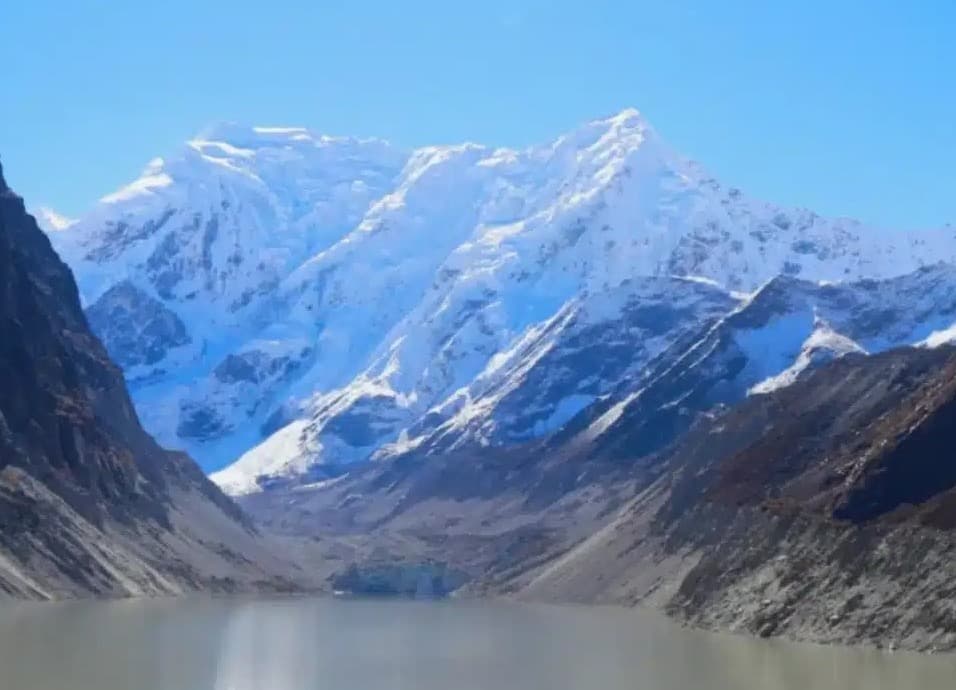Lukla village is a popular place to visit in the Khumbu area of the Solukhumbu District in Nepal. At an altitude of 2,860 meters, it is the starting point for all hiking trips in the Everest region.
Lukla contains a small air terminal, which services the district. It’s the Lukla Airport, also known as the Tenzing Hillary Airport, which is one of the highest altitude airports in the world. Besides the runway, Lukla village has almost everything, from well-established inns for travelers to an assortment of shops, internet cafes, coffee shops, and all.
Lukla has now become a commercial place because of the many trekkers, visitors, and mountaineers that come every year. Thus, though the town is small, it is full of bustling trekkers on a hiking mission to EBC.
So, here in this Lukla travel guide, we will enrich you with all the pieces of information about visiting Lukla.
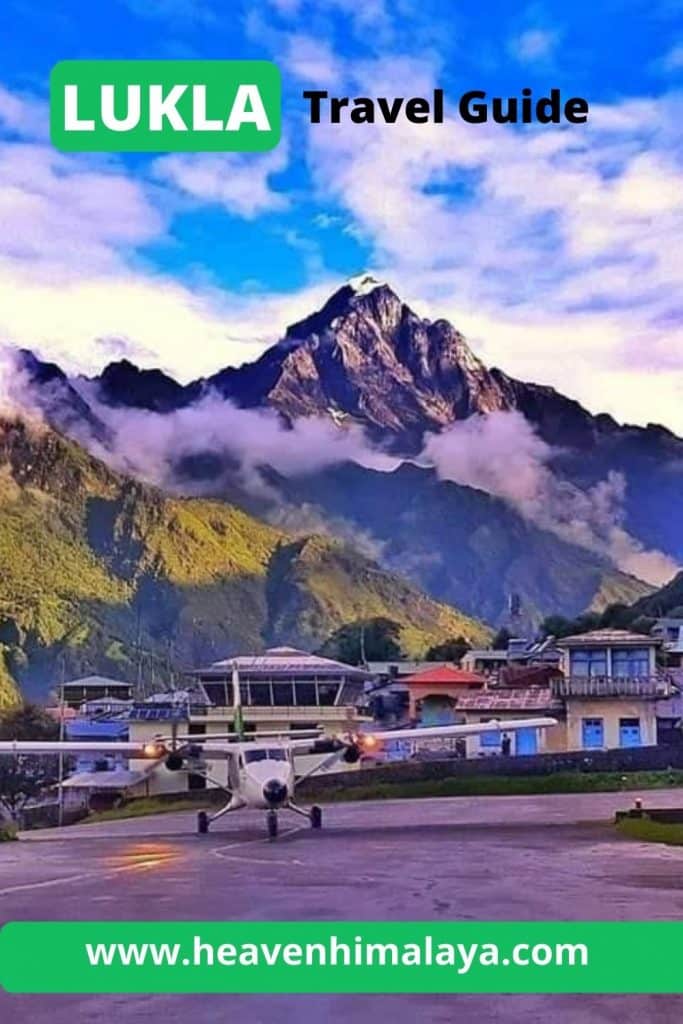
Quick facts about Lukla
The town of Lukla is at the foot of Mount Everest and is popular among travelers because of its airport. Lukla airport is small and clings to the mountainside high in the Himalayas of Nepal.
-
- Elevation: 2,860 m (9,380 ft)
- District: Solukhumbu
- Area Code: 038
- Province: 1 (Eastern).
- Zone: Sagarmatha
- Country: Nepal
- Population: Around 5000
The oldest Sherpa Monastery, Sherpa Culture, Lukla Airport, Hotels, Inns, and Tourist Coffee Shops are the chief attractions.
Places to visit near Lukla, Nepal: Bom, Muse, Chaurikharka, Nakchung, Surke, Chheplung, Tate, Nachipang, Rongdingma, Pakhepani, Sengma, Thado Koshigaun, Chheubas, Ghat, Paiya, Nurning, etc.
Let’s have a look at some other popular facts about Lukla.
- Lukla means “the area for goats and sheep.”
- It is the most popular starting point for all the treks in the Everest Region.
- It is famous for its herbage, yaks, and sheep-rearing grassland.
- Goods in Lukla are expensive because the locals use domestic planes to transport them from Kathmandu.
- Sherpas heavily inhibit the Lukla region. So, Sherpa culture and traditions are widely prevalent there.
The Best Time to Visit Lukla, Nepal
The best and ideal opportunity to visit Lukla in Nepal is spring (March-May). The temperature reaches a max of 27 degrees Celsius, which is great for trekking. Autumn is also the second-best time to explore Lukla.
The trekkers have a view of trees changing color, and the weather is neither too hot nor too cold. Thus, the November and April months are the peak times for travelers visiting Lukla.
Lukla Climate
Lukla prevails in the tundra climate. The area has a cool adaptation to the moderate environment. Summers are wet with high precipitation figures. As Lukla lies in the northern hemisphere, summer here starts in late June and ends in September.
Temperatures here are a lot lower than in the lower portions of Nepal. Even during the summer, the temperature is low.
The Lukla climate is cold, so it witnesses snow almost every time of the year. The coldest month is January, with an average high temperature of -3.9°C and an average low temperature of -14.7°C. There is the highest UV index from January to April and June to December, with an average UV index of 2. May is the month with the highest snowfall and the lowest UV index. Likewise, November is the month with the least snowfall.
Year-round, Lukla has 142.5 rainy days and 1206 mm (47.48″) of precipitation. Thus, the climate is humid most of the time. The month with the highest humidity is July, with an average relative humidity of 92%, and the least in December. Similarly, the month with the most rainfall and the least sunshine in Lukla, Nepal, is July.
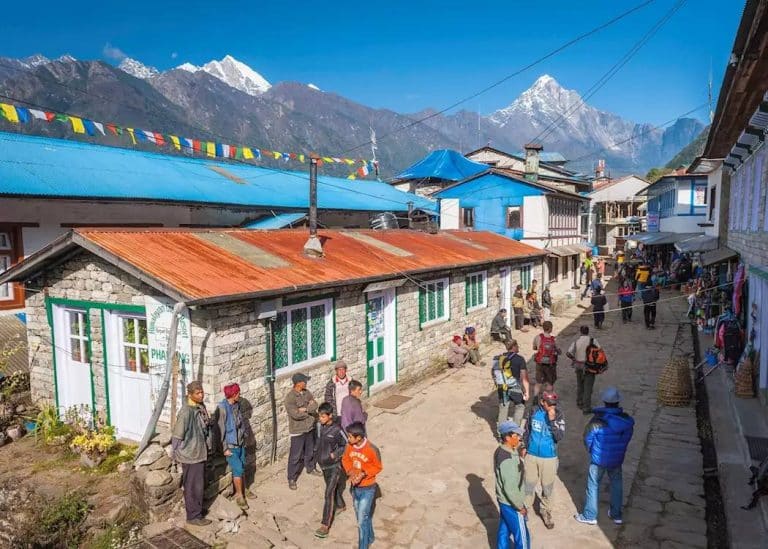
Lukla Weather According to Seasons and Months
The weather in Lukla Village is always cold and humid. However, it also has sunny days. Usually, the weather in the early morning is clear. But, the fog covers everything in the late afternoon.
Spring (February-May)
During spring, the temperatures range between (27.1°C) and (17.4°C), with warmer weather in the later months. Again, in the latter months, rain is also common, with 5 to 9 days of significant precipitation per month.
However, the weather is clear and gives unobstructed views of the mountains. The captivating clouds slide over the bright blue sky, giving the feeling of being on top of the world. Watch different species of birds living in the lush oak, pine, and rhododendron trees. The dripping river flowing through the scenic meadow gives a different vibe.
Overall, spring is the most favorable time to trek in Nepal. It’s also the best time to visit Lukla, so you will encounter many other climbers and summiteers on the way.
Summer or Monsoon (June-August)
The middle months of the year have a high temperature that is not pleasant for visitors. There is often rainfall and snowfall during the monsoon in Lukla. The trails become slippery all the time. Thus, this is the least busy season.
Because the number of trekkers is low if you visit Lukla in the summer, lodging and other accommodations are easily available. Although June to August is a rainy season, some travelers still prefer these seasons. It’s because it offers beautiful views of the hills and mountains, along with green and shiny trees that have just had a bath.
Autumn or Fall (September-November)
During autumn, the temperature ranges from 79.5°F (26.4°C) to 64.2°F (17.9°C). The weather stabilizes, and the days are sunny. Although the nights get colder, it can get hot during the day when it’s sunny.
Hence, it is one of the busiest seasons in Lukla. For the locals, it is the time to make money.
Winter (December-February)
The weather is chilly, so it may cause difficulty for warm-weather lovers. On average, there is a small amount of rainfall and snowfall (0–1 time per month).
Because the weather is cold, the flow of tourists is less compared to other months. But the view of the scenery is clear, with no disturbance. The price of accommodation and food in Lukla is lower compared to other seasons.
Lukla Airport (Tenzing Hillary Airport)
Lukla Airport is a small airport in the Sagarmatha Zone of Nepal, built-in 1964 AD under the supervision of Sir Edmund Hillary. Later, in January 2008, the airfield was renamed Tenzing Hillary Airport in honor of Sir Edmund Hillary and Tenzing Norgay Sherpa, the first people to summit Mount Everest.
The Lukla terminal has a very short and narrow paved tarmac for the runway. The length of the runway at Lukla Airport is 527 meters, and the width is 65 feet, which is much less than compared to other airports. There is no use of air navigation or radar systems. Instead, for landing and take-offs, radio communication is used. The paved road is small and is only suitable for helicopters and small aircraft with fixed wings and short takeoffs, such as Dornier 228.
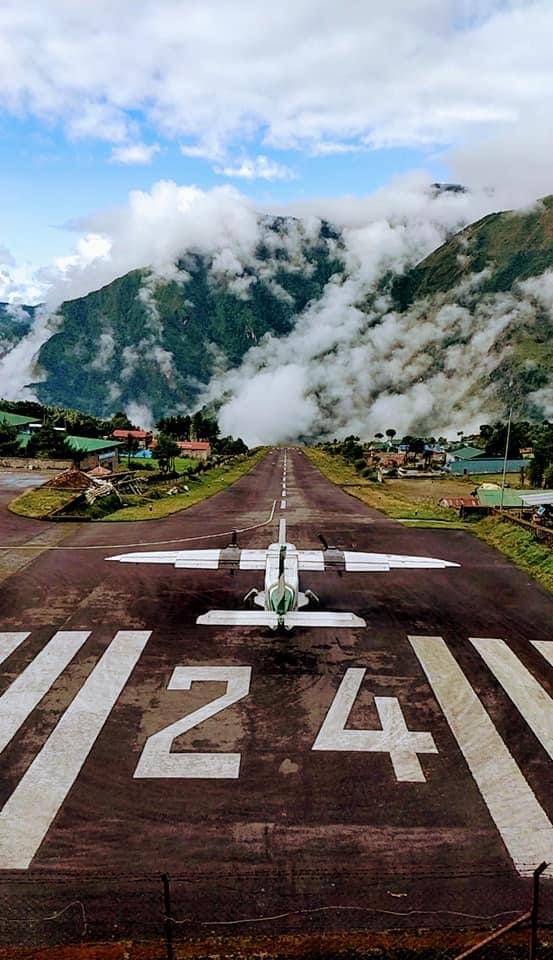
Landing at the Tenzing Hillary Airport begins from north to south, and takeoff is from south to north of the runway. The runway is secured by the Nepal Army and has a wired fence around it.
Although small, the area is always busy because of the large number of hikers that visit every year in the Everest region. It is the starting point for the popular EBC Trek Itinerary in Nepal. Besides passenger flights, locals also use it to transport most of the building materials and cargo to Lukla and other towns and villages in the Everest region.
Flight Experiences to Lukla
Even though only small planes carrying around 20 passengers can land or pick up at Lukla, the airport of Lukla has made the Everest region approachable for many people, not only mountaineers. And every year, thousands of people reach Lukla, which proves that this is a pleasant journey.
Flying to Lukla, you get a panoramic view of the snow-capped valley below. Also, during clear weather, it provides spectacular views of the 18 high mountains in Nepal, four of which are above 8,000 meters. Flying to Lukla is part of a thrilling adventure. One takes a deep breath and feels the brisk forest air fill the lungs. The small plane goes between the hills that give the best views of the mountains around.
The flight only takes place in the morning. So, the sunrise view from the plane window looks like orange light dazzlingly hitting the mountain. Sometimes, glorious rainbows seemed to stretch across the entire sky.
How to get to Lukla, Nepal
The popular option for getting into Lukla is the flight from Kathmandu or Ramechhap. Other options also include roadways or traveling by foot, which is a long and tedious journey.
From Kathmandu to Lukla by flight
-
- Flight Fare: Around 180 USD for foreigners (keeps changing).
- Distance: 138 KM (Straight line)
- Duration: 30-40 Minutes
- Popular Airlines: Simrik Airlines, Summit Airlines, and Tara Airlines
Most people travel to Lukla by plane, which takes about 30–40 minutes from Kathmandu. Several flights run each day in the early morning or daylight with pleasant weather. But, it’s not 100% guaranteed. Because of unpredictable weather, sometimes domestic flights in Nepal get delayed for at least 1 or 2 days.
Besides, the flight only allows 10 kg of luggage and 5 kg of hand-carried bags for passengers. So, pack your bag accordingly. If you have more weight, you need to pay an extra $1 per kg.
Usually, the cost of a Lukla flight from Kathmandu is 180 USD per person for foreigners and 140 USD for Indians. But, it keeps changing.
Ramechhap to Lukla Flight
Airlines operate another flight to Lukla from Manthali Airport in Ramechhap. Manthali Airport is approximately 133 km from Kathmandu, which is a 4-5-hour drive by jeep or private bus. It takes 20 minutes to reach Lukla from Manthali, with a beautiful scenic flight.
Travel to Lukla from Kathmandu by helicopter.
Another way of reaching Lukla is by helicopter. It takes 45 minutes with views of massive glaciers, staggering mountains, and wild animals. If you have very little time and need to travel to Lukla, you can book a helicopter tour with Heaven Himalaya. You can contact us here.
By road and on foot from Kathmandu to Lukla
The drive from Kathmandu to Lukla passes through several geographical terrains that offers panoramic views of Nepalese mountains, rivers, villages, culture, and countryside. There is no direct drive to Lukla.
First, we need to drive from Kathmandu to Jiri/Phaplu/Shivalaya/Bhandar/Salleri/Bupsa/Kharichola. It takes around a day to reach these places from Kathmandu. From here, a few days of hiking will take you to Lukla.
Accommodations
Lukla offers an ample choice of accommodations like teahouses, restaurants, lodges, and luxury hotels. Prices may vary depending on the facilities. Hotels provide all the facilities for trekkers that are essential during the trek. The interiors reflect the magnificent local culture and the hearty welcome by the host.
Rooms are available either with an attached toilet and hot showers or without an attached toilet. Some of them have western toilets.
The rooms in guesthouses have two single beds, a table, a trash can, a hanger, and charging ports inside. The rooms are quite warm, with thick duvets, pillows, and mattresses. Also, offer an extra blanket if needed. The services inside the hotels differ depending on the hotel, but they provide comfort for the visitors.
Almost all hotels in Lukla provide free Wi-Fi service. In the event of power cuts, visitors can easily access the internet using data packs. There is no interruption to the NTC and Ncell networks in this area. To buy data packs, visitors need to get a Nepali sim card, which is easily available in Kathmandu, Pokhara, and the local market of Lukla. Also available are POS machines that accept credit cards, laundry services, etc.
Guest House, Lodges, and Hotels
- Yeti Mountain Home
- North Face Resort
- Buddha Lodge
- Himalaya Lodge
- Lukla Airport Resort

Food and beverages in Lukla
Almost all tea houses, hotels, and lodges provide a wide variety of beverages, from traditional tea, hot lemon, hot juice, coffee, hot chocolate, and milk to beer and a large food menu in Lukla.
Most of the time, people get a variety of rice and noodle dishes in every hotel. The combination is a bowl of mixed vegetables, rice, or noodle dish with either beef or chicken. Most of them also serve cheese and vegetable pizzas, garlic soup, omelets, and chapati.
Popular breakfast options in Lukla include chapati, oatmeal, fries, mashed potatoes, boiled eggs, omelets, and porridge.
Lunch and dinner have many choices. On the treks, “Dal Bhat,” the traditional Nepalese food, is served with boiled rice, boiled lentils, vegetable curry, and cucumbers. It’s filling, healthy, and delicious.
Besides, there are all kinds of nutritious soups, fried rice, vegetable noodles (soup and fried), potatoes, vegetable momos, with tomato sauce, etc.
For dessert, you will have apple pie, fruit cocktail, chocolate cake, rice pudding, and snickerdoodle pie.
Sherpa Culture in Lukla
Sherpas are residents of Lukla. They are famous for their climbing skills, superior strength, honesty, and endurance at great heights. Most of them work in the tourism business and run tourist accommodations. They belong to Tibetan culture and speak a language called Sherpa.
The people of Lukla worship the impressive mountains of the Himalayas as gods. The Sherpas call Mount Everest Chomolungma and revere it as the “Mother of the World.” They worship Mount Makalu as the deity Shankar (Shiva).
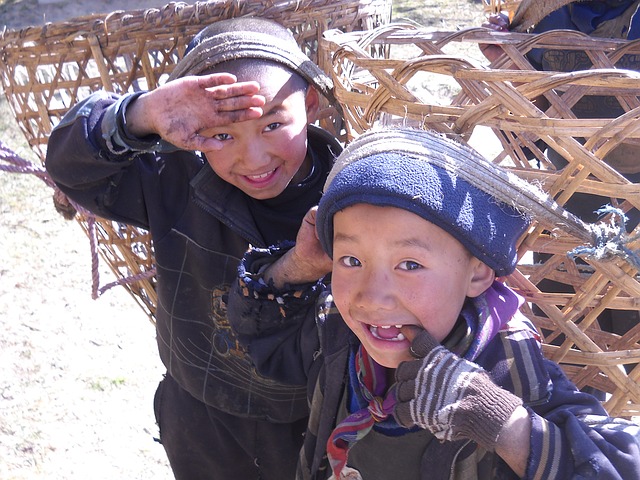
The roofs of sherpa houses are flat and usually wooden, weighed down with heavy stones. People use the lower level of the house for livestock, fodder, food, and firewood. While the upper-level houses are for living in, the floors of these rooms are wooden and covered with rugs and carpets.
Sherpas are loyal, often linked to each other, and have a sharp sense of equity. Famous for their warm hospitality, they know how to make any visitor feel welcome. Offering the ‘Khada’, a silk scarf, a symbol of respect and friendship, is the way to greet. When visiting Lukla, Sherpa Tea and freshly baked yak milk make you feel more at ease.
Traditional Wear and Sherpa Clothes in Lukla
Visitors experience ideas, values, traditions, and the lifestyle of the locality. Both men and women wear a long undershirt over a pant-like garment made of wool. Over this, they wear a thick, Kho or Bakhu that reaches below the knees and fastens to the side.
Around their waist, they wear a belt called a sash. They wear high, woolen boots with hidden soles. Sherpa women in Lukla wear various ornaments and a peculiar cap called Shyamahu.
Major Sherpa Festivals in Lukla
Lhosar is a major cultural festival that marks the new year on the lunar calendar. Also, they celebrate the Mani Rimdu festival, which is the biggest festival of the Sherpas and takes place in October and November.
The celebration of Mani Rimdu usually takes place in major monasteries such as Chiwong, Thame, and Tengboche Monastery. More so, Dumje is their other major festival.
Things to do in Lukla
Lukla is a beautiful city, full of hotels, lodges, and inns that provide good views of the surrounding mountains. It is the popular stop point for popular travel packages to Everest. People come here to relax and enjoy being in the mountain’s lap while trying to escape from a busy schedule of daily activities.
Here’s a list of a few things to do in Lukla, Nepal.
- Enjoy the local food and drinks.
- Private and custom tours.
- Experience the Sherpa history and culture of the locality.
- Explore Sherpa monastery.
- A thrilling adventure of outdoor activities.
- Exquisite helicopter tours.
- Trek to Kalapatthar from where travelers can see dawn’s views in the middle of the panoramic view of the Everest area.
- Enraptured by the sight of mountains, snowfall, and rivers,
- The ravishing vision of the ancient scriptures of Tibet
- The mesmerizing view of beautiful village temples, chortens, and smaller religious shrines, and the Mani wall, made of slabs of stone inscribed with prayers and sacred texts.
Treks near Lukla
Lukla is the starting and ending point of almost all kinds of treks in the Everest region of Nepal. It is the first stop for accommodation during the EBC hike while Gorakshep is the last stop.
The small Sherpa town of Lukla connects every village and popular route in the Everest zone. So, the explorers have an assortment of choices for traveling close to Lukla. Here is a list of a few well-known trips close to Lukla:
EBC Trek
This trek is popular among explorers as the route takes you to the lap of the world’s highest mountain, Mt. Everest. The path leads to steep-jagged peaks, valleys, and glaciers, and finally to the soaring height of 5540 m.
The EBC Trek from Lukla is an opportunity to experience different ecological associations of flora, fauna, and majestic mountains and rivers.
Everest Luxury Trek
Enjoy the beautiful landscapes of the Himalayan Assortment near the Khumbu region with an Everest Luxury Trek. Also, get an insight into the lives of the world-famous mountaineers, the Sherpas. Plus, explore the World Heritage Site, Sagarmatha National Park, and the world’s highest Buddhist monasteries.
This trek allows you to enjoy views of the Everest range with the modern amenities in the hotels and teahouses. This is the luxury version of the normal, budget-friendly EBC hike.
Gokyo Lake Trekking
The trek ascends to the oligotrophic lakes of Gokyo and the larger Ngozumpa Glacier, which lies within a basin of gigantic mountains. Also, the trek to Gokyo Ri provides views of mighty mountains like Cho Oyu, Everest, Lhotse, and many more, adding even more beauty to this trip.
The route to Gokyo Lake is remote and less populated. Trekkers get pure and genuine interaction with the local people on the regular path. The solitude of the place, combined with a mix of pristine landscapes, makes this trip one of the best treks in Nepal.
Several treks in the Everest region offer unsettling views of the mountain peaks. Only a few hikes allow you to enjoy seeing enormous mountains up close. And, the Everest Gokyo Lake Trek is one of them.
Trekking to Everest’s Three Passes
This is the full-circuit trek in the Khumbu region. During this trek, visitors cross three high passes on Everest, including Cho La Pass (5,420m), Kongma La Pass (5,535m), and Renjo La Pass (5,360m). Everest Three Passes Trek is the ideal choice for an exciting adventure. It is the best option for a traveler looking for a challenging and advanced trek in Nepal.
The trail crosses the Cho La pass in the Dudh Koshi valley. From there, it heads to Everest Base Camp. Trekking through the serene beauty of the Himalayas and rhododendron forest is a rare moment. Sherpa hospitality energizes you in such a harsh landscape of yaks and sheds, and rocky and snowy surfaces.
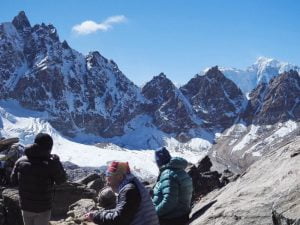
Everest to Chola Pass Trek
The Everest Chola Pass Trek leads to the delightful scenic valleys of Gokyo. The lovely trail to Gokyo Valley and many neighboring mountains of the Everest region, like Mt. Makalu, Mt. Lhotse, Mt. Cho Oyu, and many more, make you feel you are in the seventh heaven. This trek passes through villages like Phakding, Namche Bazaar, and Tengboche.
Mountaineers in the region, such as Ama Dablam (6856m), Kantega (6809m), Mt. Nuptse (7879m), and many more, besides Everest, give a sensational feeling to trekkers. The Sherpa’s friendly demeanor and the other ethnicities in the area are a lasting memory of this trip. Besides this, the early morning fog gives the lake an ethereal appearance. Thus, if you have time, go on a Chola Circuit Trek from Lukla.
In the end,
In the above ultimate travel guide to Lukla, we discussed the weather, the best time, climate, culture, best treks nearby, transportation, food, accommodations, etc. More, if you have any queries regarding Lukla, you may ask in the comments below.




